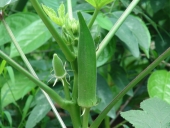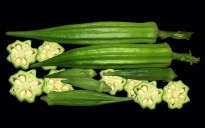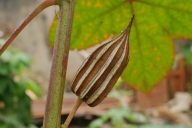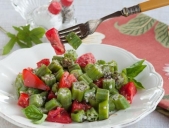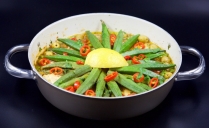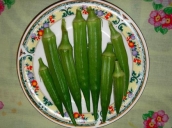| Okra - Abelmoschus esculentus | |||||||||||||||||||||||||||||||||||||||||||||||
|---|---|---|---|---|---|---|---|---|---|---|---|---|---|---|---|---|---|---|---|---|---|---|---|---|---|---|---|---|---|---|---|---|---|---|---|---|---|---|---|---|---|---|---|---|---|---|---|
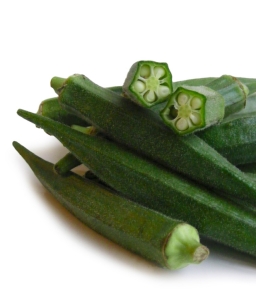 Fig. 1  Okra Abelmoschus esculentus 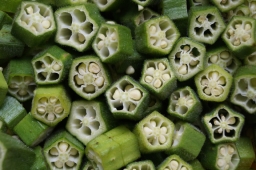 Fig. 2  Sliced okra 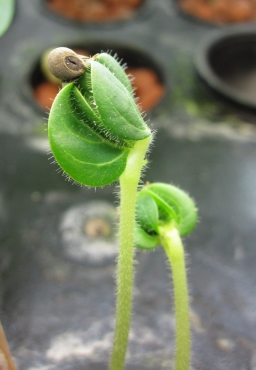 Fig. 3  Okra seedlings 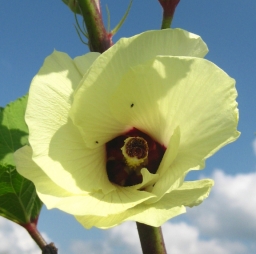 Fig. 4  Okra, A. esculentus 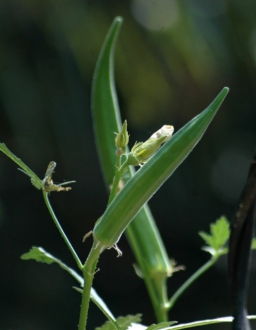 Fig. 5  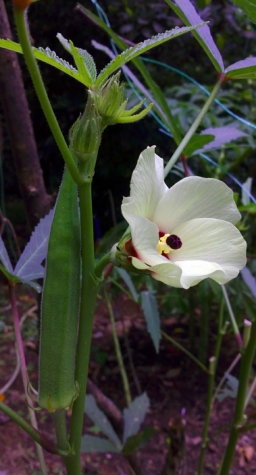 Fig. 6  Okra flower and seed pod A. esculentus 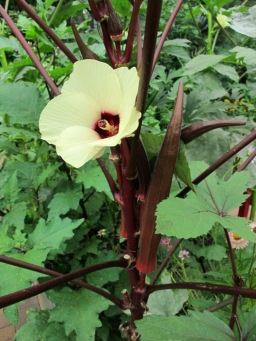 Fig. 7  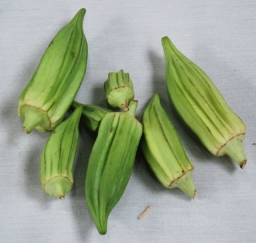 Fig. 13  'Star of David' 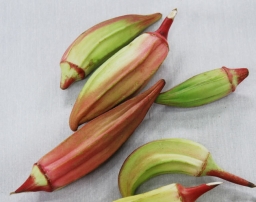 Fig. 14  'Hill Country Red'  Fig. 21  Habit  Fig. 22  Mizuka with our giant okra plant  Fig. 23  A. esculentus (L.) Moench, Malaysia  Fig. 27  Koyambedu Market, India 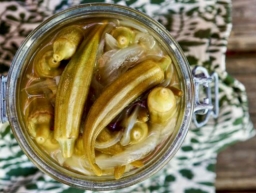 Fig. 28  Quick pickled okra 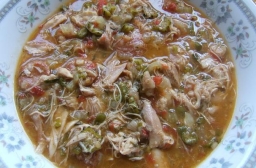 Fig. 29  Chicken gumbo Luisiana style 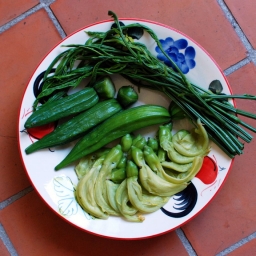 Fig. 30  Steamed vegetables  Fig. 31  Sweet potato and okra salad |
Scientific
name Abelmoschus esculentus (L.) Moench Common names English: gumbo, lady's-fingers, okra; French: gombo, okra; German: eßbarer Bisameibisch, Ocker; Hindi: bhindi; Indonesian: kopi arab; Italian: gombo, ocra; Malay: kacang bendi; Portuguese (Brazil): quiabo; Spanish: gombo; Swedish: okra; Transcribed Chinese: ka fei huang kui; Transliterated Russian: bamiâ 2 Synonyms A. bammia Webb, A. longifolius (Willd.) Kostel., A. officinalis (DC.) Endl., A. praecox Sickenb., A. tuberculatus Pal & Singh, A. tuberculatus var. deltoidefolius T. K. Paul & M. P. Nayar, Hibiscus esculentus L., H. esculentus var. praecox (Forssk.) A. Chev., H. esculentus var. textilis A. Chev., H. ficifolius Mill. Unresolved, H. hispidissimus A. Chev. [Illegitimate], H. longifolius Willd., H. praecox Forssk. 1 Relatives Cotton, Gossypium spp.; cranberry hibiscus, false roselle, H. acetosella; Indian hemp, kenaf, H. cannabinus; sunset hibiscus, A. manihot; roselle, H. sabdariffa Family Malvaceae (mallow family) Origin Old World tropics (West Africa) 6 USDA hardiness zones 2-11 10 Uses Food, borders, containers, medicine - folklore 2,10 Height 3-5 ft (90-240 cm) 10 Plant habit Tropical, upright, herbaceous to slightly woody 6 Growth rate Fast Life cycle/span Annual; warmer regions: perennial Stem Stems often red blotched, coarse 11 Pruning requirement Ratoon 2-3 times for subsequent harvesting 5 Leaves Edible hairy, dark green leaves are deeply cut into 3-7 lobes 10 Flowers Hibiscus-like, showy, yellow with purple center 10 Pod/seed Edible capsules are cylindric, slightly 5-angled, beaked, 3-12 in. (8-30 cm) 11 Harvest season Mar. through Nov. 5 Days to harvest from seed 48-80 depending on variety Soil Prefers moist, moderately fertile and well drained; tolerant of poor soils 6,10 pH preference 6.8–6.0 4 USDA Nutrient Content: raw pdf Light requirement Full sun Water requirement Grows best when irrigated; drought tolerant Cold tolerance Frost injury at 3 °F (-19 °C) below freezing 5 Temperature requirement 50-100 °F (10-38 °C) Optimum soil temperature 75-90 °F (24-32 °C) 20 Invasive potential * None reported Known hazard Some people develop skin rashes when working with this plant (wear gloves to avoid contact with stems and leaves) 10 Reading Material Okra Production in Miami-Dade County, Florida, University of Florida pdf Grow your own Okra, University of Florida, Osceola County Mallow Madness, Eat The Weeds Abelmoschus esculentus, Floridata Origin Okra is native to the Old World tropics (West Africa) and has become established in the wild in some New World tropical areas. It is believed that okra first reached the New World during the days of slave trafficking. Okra is often known as lady's fingers outside of the United States, and gumbo in parts of the United States and English-speaking Caribbean, based on a corruption of the Portuguese word "quingombo," which is in turn a corruption of the word "quillobo," the word for the plant in some parts of eastern Africa. 6 Description Okra, an annual crop, produces pretty flowers followed by edible seed pods which are popular fresh and cooked, and an important food worldwide. A. esculentus is among the most heat and drought tolerant vegetable species in the world. 6 It is very sensitive to frost and cold temperatures and should not be planted until soil has warmed in the spring. In Florida, okra is predominantly grown in Alachua, Columbia, Dade, Jackson, Jefferson and Lake counties. 14 Yields of the crop range from less than 600 bushels/acre to more than 1000 bushels/acre. 5 While fresh okra is widely enjoyed by consumers, a large quantity of it is sold to soup companies. 14
Fig. 8. Okra plant with a fruit and spent flower, Hong Kong Fig. 9. Okra plant Seed Okra has a thick seed coat and does not germinate easily. Scarify. Soak seeds in water at room temperature overnight to improve germination. Discard non viable seeds that float after soaking. 17 Seeds are sensitive to cold temperatures and should not be planted outside until soil temperatures have risen to 60°F and night temperatures no longer dip below 55°F. Seed may be started indoors about 1-2 weeks prior to last frost date with seedling planted outside as soon as soils warm. 10 Seed can be saved from open-pollinated varieties. 17 Seed storage 2 years Seeds/oz 450-550 20 Sowing season North: Mar.-June; Central: Feb.-Aug.; South: Jan.-Mar./Aug.-Oct. 4 Minimum soil temperature for germination 60 °F (16 °C) Minimum night temperature 55 °F (13 °C) 10 Plant population (acre) 43,560 20 Seeding depth ½-1 in. (1-2.5 cm) Distance between plants 4-10 in. (10-25 cm) Distance between rows (in) 36-60 in. (91-150 cm) 4 Plants per 10 ft2 (3 m2) 12-30 Yield per 10 ft (3 m) 10 lb (4.5 kg) 7
Fig. 10. Fruit opened Fig. 11. Seeds Fig. 12. Dried okra pod Planting Okra is seeded directly into the soil. Often growers plant okra following a winter vegetable crop, so that the fruits are harvested from early spring to late fall. 5 Short day length, less than 11 hours, promotes flowering in most cultivars. Okra planted too late in the spring may remain vegetative until late summer or early fall. The cultivar ‘Clemson Spineless’ is less sensitive to day length. 17 If you are growing okra mainly for its edible leaves, plant the seed closer together. If you want to eat both leaves and pods, harvest about 1/3 of the leaves when they are still young and tender. 19 Leaves Leaf blades scarcely lobed to palmately divided, 4-10 in. (10-25 cm), ± broader than long 11
Flowers Species plants feature hibiscus-like, 2-3" wide, yellow flowers with purplish centers. Flowers last only for one day, but plants bloom freely throughout the growing season to frost. Cultivars expand the available flower colors to include attractive shades of pink, orange-red and red, often with white centers. 10
Pollination Okra is generally self pollinated, but it will be cross pollinated by insects, such as bumble bees, when several varieties are grown in close proximity and blossom at the same time. For seed saving flowers can be isolated by placing a paper bag over them for 24 hours while they are open. In early fall, allow several pods to mature and dry. 17 Pods Flowers give way to fruit capsules which have a musky aroma 10
Fig. 24 Growing in Hong Kong Fig. 25 Fruit capsules Fig. 26 Dried fruit capsule Cultivars Annie Oakley II (dwarf hybrid), Cajun Delight (hybrid), Clemson Spineless, Clemson Spineless 80, Emerald, Millionaire (hybrid), North and South (hybrid), Spike (hybrid). 4,7 Fast-maturing dwarf varieties are [usually] recommended for use in temperate regions. 16 Harvesting First pods are ready for harvest about 2 months after planting, but plants continue to bloom and set if all pods are harvested at the proper early stage. Okra is generally similar in culture and exposure to summer squash, except the plants are tall and upright with many short branches. 15 Pick pods at least every second day to avoid the development of large, undesirable pods. 13 Harvest pods a few days after flower petals have fallen when they are about 2-3 in. (5-8 cm) long and before they become tough and stringy. 7,10 Okra is hand-picked and sold for local consumption, but primarily for shipment to other states. 5 Amount to raise per person: 9 lb (4.1 kg) 17
Okra in the Summer Garden. Learn about okra in summer’s heat and when to harvest for tender fruit with UF/IFAS Extension Escambia County. v1 Storage For the home gardener okra can be stored in the refrigerator for 2-3 days. 14 Keep dry or pods will darken and become slimy. 17 Okra should be kept at temperatures between 50-55 °F (10-13 °C) and of 85% to 90% relative humidity. Okra pods are subject to chilling injury below 50 °F (10 °C). Okra is best when cooled using the forced-air cooling method or pressure cooling, refrigerated room air is drawn at a high flow rate through specially stacked containers by means of a high capacity fan. This method can cool as much as four times faster than room cooling. Okra can then be stored at 45-50 °F (7-10 °C) at 90-95 % relative humidity for approximately 7-10 days. 13 Pruning/Ratooning Market price for okra typically declines sharply as the summer progresses. After the market price drops, consider ratooning or cutting back your okra. Ratooning okra will allow the plants to rejuvenate and produce a crop in the fall, when okra prices are generally higher. Cut plants back using a mower, leaving 6-12 in. (14-30 cm) of each plant above the ground. Re-fertilize to encourage re-growth and the development of side branches. Fall yields of cutback okra will often exceed that of spring crops or the yields of a crop that is not cut back. 13 Fertilizing The total amount of fertilizer required in Miami-Dade County depends on the variety, soil fertility, and other environmental factors. It may be possible to use less inorganic fertilizer if a cover crop has been grown or if a soil organic amendment (compost, biosolids, and manure) has been applied. Pre-plant fertilizer formulas of 6-6-6, 6-3-6, 10-10-10, or similar formulas are satisfactory. For okra on flat ground, all of the P and 20%–30% N and K should be broadcast and incorporated prior to planting. The remainder of the fertilizer should be side-dressed in 2 or 3 applications beginning at 3–4 weeks after planting. Okra is often planted as a second crop on plastic mulch. In this case, the fertilizer is provided by fertigation once or twice a week with daily rates ranging from 0.5 lb N to 2 lb N/acre. Magnesium nitrate or sulfate and EDDHA-chelated iron should be applied if deficiency symptoms appear. 5 Irrigation Moisture is especially important during flowering and pod development. During prolonged dry periods, a deep soaking once every seven to 10 days with one to 1.5 in. (4 cm) of water should be adequate. Soaker hoses or drip irrigation tape are the best methods for applying water. 12 Culture Requires warm soils and temperatures. Very heat tolerant. 7 Pests Highly susceptible to root-knot nematodes. 7 Arthropod pests of okra include caterpillars (larvae of Lepidoptera), aphids, thrips, whiteflies, and mites. 8 Although the silverleaf whitefly develops prolifically on okra, the plant compensates for the feeding damage. The main concern is that tremendous numbers of this pest migrate from okra fields to other crops, such as tomato, bean, and ornamental crops. 5 Leaf-feeding caterpillar pests (lepidopteran larvae) that attack okra include beet, southern, and fall armyworm, cabbage looper, and corn earworm. Cabbage looper and corn earworm can also bore into pods. Melon thrips and southern green stink bug can also cause serious damage. Because of limited options for chemical control of insects, conservation of natural enemies is important and possible. As with all crops, destruction of the crop after harvest can help reduce pest populations. The practice of prolonging production by topping plants may contribute to pest problems even though it reduces the cost of production. 8 Melon Aphid or Cotton Aphid, Aphis gossypii Glove, University of Florida pdf Nematode Management in Okra, University of Florida pdf Marigolds (Tagetes spp.) for Nematode Management, University of Florida pdf Whitefringed Beetles, Naupactus spp., University of Florida pdf Diseases Anthracnose, bacterial leaf spot, cercospora leaf spot, phytophthora, pod spot, powdery mildew, pythium damping-off. 4 Food Uses Okra is commonly used in a number of cuisines including Creole, Cajun, Caribbean, Southeast Asian and Middle Eastern. 14 • Pods. Very small pods are great eaten raw. 9 Okra flavors well with peppers, eggplants, onions and tomatoes. When okra is cut, it releases a sticky substance with thickening properties that can be used in soups, gumbos and stews. Wait to season your okra when sautéing. If you add salt at the beginning of the cooking process or during, it can result in sticky okra. 14 Harvest too big? Pickle it, or simply trim stems, blanch, bag, and freeze. 9 • Leaves. Can be eaten raw when very young but are usually best stir-fried or added to soups. Remove stems before cooking. An excellent calcium source. Dried they contain over 25% protein. Either fresh or dried, are excellent for thickening soups and stews. 19 • Flowers. Can be eaten raw or fried. 9 • Seeds. Ripe seeds, washed and ground, are said to furnish a palatable substitute for coffee. 18
Fig. 32. Laksegryte. Salmon okra casserole Fig. 33. Stuffed okra, North Indian style Fig. 34. Okra tomato salad Fig. 35. Okra, gombos Fig. 37. Lady's finger fry Preserving Okra, University of Florida Roasted Okra and Tomatoes recipe, All-America Selections Edible Flowers, Colorado State University pdf Nutritional Value Okra contains fiber and antioxidants that promote heart health. Cooked okra is a great source of folate. 14 It is high in Vitamin C, fiber, and flavonoids. 9 Other Uses Mature okra can be used to make rope and paper. 14 Other Edibles in the Malvaceae family: Sunset hibiscus, Abelmoschus manihot Roselle, Hibiscus sabdariffa not to be confused with false roselle, H. acetosella General The name "okra" is of West African origin and is cognate with "ọ́kụ̀rụ̀" in Igbo, a language spoken in Nigeria. In various Bantu languages, okra is called "kingombo" or a variant thereof, and this is the origin of its name in Portuguese, Spanish, Dutch and French. The Arabic "bāmyah" is the basis of the names in Cyprus, the Middle East, the Balkans, Iran, Afghanistan, Greece, North Africa and Russia. In Marathi, it is called Bhendi (भेंडी). In Southern Asia, its name is usually a variant of "bhindi" or "vendi" (வெண்டை in Tamil). This is one of the most popular dishes in the whole of India. In the Northern India, this is consumed as a processed vegetable as "bhindi masala" and in the south the list is long namely Poriyal (dry fry), Aviyal (gravy fry), Morekolambu (dish with curd). In Vietnam, it is called đậu bắp and is used in sour soup dish. In Nepal, it is called Ram Toriya and used in different ways. Ram Toiya fried with tomato is famous in Nepal. 6 Further Reading Florida Vegetable Gardening Guide, University of Florida pdf Propagation by Seed Vegetable Production Handbook of Florida, University of Florida pdf Botanical Art
Fig. 38. Horti medici Amstelodamensis rariorum tam Orientalis (1697-1701) Fig. 39. La gombeau. Comestible. Flore d’Amérique (1843-1846) Older Material Musk Seed, 1931, A Modern Herbal Hibiscus, 1919, 1972, Sturtevant’s Edible Plants Of The World List of Growers and Vendors |
||||||||||||||||||||||||||||||||||||||||||||||
| Bibliography 1 "Synonyms for Abelmoschus esculentus (L.) Moench." The Plant List (2013), Version 1.1, www.theplantlist.org. Accessed 18 July 2020. 2 "Taxon: Abelmoschus esculentus (L.) Moench. Okra." USDA, Agricultural Research Service, National Plant Germplasm System, Germplasm Resources Information Network (GRIN-Taxonomy), National Germplasm Resources Laboratory, Beltsville, Maryland, 2020, U.S. National Plant Germplasm System, npgsweb.ars-grin.gov/gringlobal/taxonomydetail.aspx?id=619. Accessed 18 July 2020. 3 Wunderlin, R. P., et al. "Abelmoschus esculentus." Institute for Systematic Botany, University of South Florida, Tampa, S. M. Landry and K. N. Campbell (application development), USF Water Institute, 2020, Atlas of Florida Plants, florida.plantatlas.usf.edu/plant.aspx?id=1716. Accessed 19 July 2020. 4 Miller, Christian F., et al. "Celery, Okra, and Parsley." Vegetable Production Handbook of Florida, 2019-2020, Horticultural Sciences Dept., UF/IFAS Extension, EDIS, edis.ifas.ufl.edu/pdffiles/CV/CV29200.pdf. Accessed 24 July 2020. 5 Klassen, Y. C. Li, W., et al. "Okra Production in Miami-Dade County, Florida." Horticultural Sciences Dept., UF/IFAS, HS-857, Original pub. June 2001, Revised Apr. 2006, Nov. 2017, EDIS, edis.ifas.ufl.edu/tr009. Accessed 25 July 2020. 6 "Abelmoschus esculentus (L.) Moench." EcoPort, no. 289, 13 Jan. 2019, ecoport.org/ep?Plant=289. Accessed 25 July 2020. 7 Brown, Sydney Park, et al. Florida Vegetable Gardening Guide." Horticultural Sciences Dept., UF/IFAS Extension, SP103, Original pub. Dec. 1999, Revised Oct. 2015, Jan. 2016, May 2018, EDIS, edis.ifas.ufl.edu/vh021. Accessed 17 July 2020. 8 Webb, Susan E. "Insect Management for Okra." Entomology and Nematology Dept., UF/IFAS Extension, ENY-466, Original pub. July 2002, Revised Sept. 2007, Feb. 2010, June 2013, Feb. 2017, EDIS, edis.ifas.ufl.edu/ig152. Accessed 26 July 2020. 9 Sullivan, Jessica. "Home Gardening = Food Security. Grow your own." BLOGS, Agriculture Faculty, 24 Mar. 2020, UF/IFAS Extension-Osceola County, blogs.ifas.ufl.edu/osceolaco/2020/03/24/home-gardening-food-security/. Accessed 26 July 2020. 10 "Abelmoschus esculentus." Plant Finder, Missouri Botanical Garden, www.missouribotanicalgarden.org/PlantFinder/PlantFinderDetails.aspx?taxonid=282605&isprofile=0&chr=19. Accessed 26 July 2020. 11 "Abelmoschus esculentus." Flora of North America, eFloras, www.efloras.org/florataxon.aspx?flora_id=1&taxon_id=200013666. Accessed 26 July 2020. 12 Warner, Kathy. "I am interested in growing okra, is it too late?" BLOGS, 15 July 2017, UF/IFAS, blogs.ifas.ufl.edu/nassauco/2017/07/15/q-interested-growing-okra-late/. Accessed 26 July 2020. 13 Kemble, J. M., et al. "Southeastern U.S. Vegetable Crop Handbook 2020." Southeastern Vegetable Extension Workers Group, College of Agricultural and Environmental Sciences, University of Georgia, CAES, vegetables.caes.uga.edu. Accessed 25 July 2020. 14 "Okra." All About Florida Products, Florida Department of Agriculture and Consumer Services, fdacs.gov/Consumer-Resources/Health-and-Safety/Living-Healthy-in-Florida/Healthy-Learning/All-About-Florida-Products/Okra. Accessed 25 July 2020. 15 Magness, J. R., et al. "Okra." NewCROP™, 1971, hort.purdue.edu/newcrop/Crops/Okra.html. Accessed 29 July2020. 16 "Okra Varieties." Echo community, www.echocommunity.org/en/plants/4/plant_varieties. Accessed 30 July 2020. 17 Andersen, Craig R. "Okra." Home Gardening Series, University of Arkansas, www.uaex.edu/publications/pdf/FSA-6013.pdf. Accessed 2 Aug. 2020. 18 Sturtevant, E. Lewis. Sturtevant’s Edible Plants Of The World. 1919, Edited by U. P. Hedrick, New York, Dover Publications, 1972. 19 Kennedy, David. "Leaf for Life Handbook: How to Combat Malnutrition and Improve Food Security With Green Leaf Crops." Leaf for Life, p. 61, 2012, leafforlife.org/gen/leaf-for-life-handbook/index.html. Accessed 7 Aug. 2020. 20 Agehara, Shinsuke, and Bielinski M. Santos. "Seed Quality and Seeding Technology." Horticultural Sciences Dept., UF/IFAS Extension, HS713, June 1995, Revised July 1996, Sept. 2001, Dec. 2005, Sept. 2007, and Mar. 2017 (minor revisions by S. Agehara), EDIS, edis.ifas.ufl.edu/cv103. Accessed 9 Aug. 2020. Videos v1 Bolles, Beth. "Okra in the Summer Garden." In The Garden with Escambia County Extension, 9 July 2020, UF/IFAS, blogs.ifas.ufl.edu/escambiaco/category/home-landscapes/fruits-and-vegetables/. Accessed 17 July 2020. Photographs Fig. 1 FotoosVanRobin. "Okra for Salmon Gumbo." Foodista, 27 Jan. 2010, (CC BY 3.0), www.foodista.com/recipe/48XWT2GZ/salmon-gumbo. Accessed 5 Aug. 2020. Fig. 2 Santanu_Manna. "Sliced okra." Pixabay, 1 June 2018, pixabay.com/photos/lady-s-finger-vegetables-sliced-3445963/. Accessed 3 Aug. 2020. Fig. 3 skeeze. "Okra seedlings." Pixabay, 9 May 2010, pixabay.com/photos/seedling-hydroponic-plant-okra-621913/. Accessed 3 Aug. 2020. Fig. 4 Rulkens, Ton. "Okra (Abelmoschus esculentus). The flower of Okra (= "lady's fingers", Abelmoschus esculentus, Malvaceae) cultivated close to Chimoio town in Mozambique. The green fruit is eaten as a vegetable." Encyclopedia of Life, via Flickr Group, no. 4451110458, 22 Mar. 2010, EOL, (CC BY-SA 2.0), eol.org/media/6752038. Accessed 4 Aug. 2020. Fig. 5 Ahamed, Riyaz. "Vendakka." Encyclopedia of Life, via Malayalam Wikipedia, no. 12724326, 25 Aug. 2009, EOL, (CC-BY-SA-2.5,2.0,1.0), seol.org/media/8059759. Accessed 4 Aug. 2020. Fig. 6 Sailesh. "Okra flower and seed pod, Abelmoschus esculentus." Encyclopedia of Life, via Wikimedia Commons, no. 19109534, 31 July 2011, EOL, (CC BY-SA 3.0), eol.org/media/8059771. Accessed 4 Aug. 2020. Fig. 7 Paulus, Kristine. "Abelmoschus esculentus. Swindler Cove Park." Encyclopedia of Life, via Wikimedia Commons, no. 24723384, 4 Aug. 2012, (CC BY 3.0), eol.org/media/8059779. Accessed 4 Aug. 2020. Fig. 8 Earth100. "Okra Plant, with a fruit and dying flower, growing in Hong Kong." Encyclopedia of Life, via Wikimedia Commons, no. 24723384, 4 Aug. 2012, EOL, (CC BY-SA 3.0), eol.org/media/8059775. Accessed 4 Aug. 2020. Fig. 9 feraugustodesign. "Okra plant." Pixabay, 17 Oct. 2013, pixabay.com/photos/okra-plant-vegetable-irrigation-588935/. Accessed 3 Aug. 2020. Fig. 10 Talbot, H. Alexander. "Okra (Abelmoschus esculentus) fruit opened." Encyclopedia of Life, via Wikimedia Commons, no. 28822301, 16 July 2008, EOL, (CC BY 3.0), eol.org/media/8059828. Accessed 4 Aug. 2020. Fig. 11 Planteur. "Abelmoschus esculentus (L.) Moench; seeds. Deutsch: Okra Samen" Encyclopedia of Life, via Wikimedia Commons, no. 26782428, 28 Jan. 2012, EOL, (CC BY 3.0), eol.org/media/8059823. Accessed 4 Aug. 2020. Fig. 12 suryawanshivishwas. "Lady finger. Dried okra." Pixabay, 19 Jan. 2017, pixabay.com/photos/ladyfinger-dry-food-green-healthy-2981856/. Accessed 3 Aug. 2020. Fig. 13 "Star of David Okra." Trade Winds Fruit, www.tradewindsfruit.com/star-of-david-okra-seeds. Accessed 29 July 2020. Fig. 14 "Hill Country Red Okra." Trade Winds Fruit, www.tradewindsfruit.com/hill-country-red-okra-seeds. Accessed 31 July 2020. Fig. 15 Starr, Forest, and Kim. "Abelmoschus esculentus (Okra, gumbo, lady's finger). Leaves. Greenhouse behind galley Sand Island, Midway Atoll, Hawaii." Starr Environmental, no. 080607-7274, 7 June 2008, (CC BY 4.0), www.starrenvironmental.com/images/image. Accessed 4 Aug. 2020. Fig. 16 Yosri. "Bahasa Melayu. Leaves." Encyclopedia of Life, via Wikimedia Commons, no. 15132014, 19 July 2006, EOL, (CC BY-NC 3.0), eol.org/media/8059763. Accessed 4 Aug. 2020. Fig. 17 Devanshy. "Vendakka3." Encyclopedia of Life, via Wikimedia Commons, no. 12658536, 24 Oct. 2007, EOL, (CC BY 3.0), eol.org/media/8059758. Accessed 4 Aug. 2020. Fig. 18 Kwan. "Abelmoschus esculentus. Lady's Finger, Okra." The Plant Observatory, no. DSC01118, www.NatureLoveYou.sg/Abelmoschus%20esculentus/Main.html. Accessed 5 Aug. 2020. Fig. 19 Kwan. "Abelmoschus esculentus. Lady's Finger, Okra." The Plant Observatory, no. DSC01124, www.NatureLoveYou.sg/Abelmoschus%20esculentus/Main.html. Accessed 5 Aug. 2020. Fig. 20 Kwan. "Abelmoschus esculentus. Lady's Finger, Okra." The Plant Observatory, no. DSC01120, www.NatureLoveYou.sg/Abelmoschus%20esculentus/Main.html. Accessed 5 Aug. 2020. Fig. 21 Judgefloro. "Okra Abelmoschus esculentus." Encyclopedia of Life, via Wikimedia Commons, no. 34356275, 30 July 2014, EOL, (CC BY 3.0), eol.org/media/8059838. Accessed 4 Aug. 2020. Fig. 22 Joi Ito. "Mizuka with our giant okra plant." Encyclopedia of Life, via Wikimedia Commons, no. 17426696, 14 Sept. 2008, EOL, (CC BY 3.0), eol.org/media/8059766. Accessed 4 Aug. 2020. Fig. 23 Morad, Ahmad Fuad. "Abelmoschus esculentus (L.) Moench. Jeniang, Kedah, Malaysia." Encyclopedia of Life, via Flickr Group, no. 5929199468, 6 Oct. 2010, EOL, (CC BY-NC-SA 2.0), eol.org/media/6752040. Accessed 4 Aug. 2020. Fig. 24 Earth100. "Okra Plant, growing in Hong Kong." Encyclopedia of Life, via Wikimedia Commons, no. 20903977, 25 Aug. 2012, EOL, Public Domain, eol.org/media/8059774. Accessed 4 Aug. 2020. Fig. 25 TJENA. "Okra vegetable." Pixabay, 4 May 2019, Image cropped, pixabay.com/photos/gombos-exotic-vegetable-okra-green-4173718/. Accessed 3 Aug. 2020. Fig. 26 patrick_dongo. "Plant, okra, food." Pixabay, 25 Aug. 2013, pixabay.com/photos/plant-okra-food-2224217/. Accessed 3 Aug. 2020. Fig. 27 Savage, McKay. "India - Koyambedu Market - Ladies Finger." Encyclopedia of Life, via Wikimedia Commons, no. 23465750, 5 Oct. 2009, EOL, (CC BY 3.0), eol.org/media/8059778. Accessed 4 Aug. 2020. Fig. 28 Simmer + Sauce. "Quick Pickled Okra." Foodista, 27 June 2019, (CC BY 3.0), www.foodista.com/recipe/DRMQ8ZMW/quick-pickled-okra. Accessed 5 Aug. 2020. Fig. 29 Roldan, Annie. "Chicken Gumbo Luisiana Style." Foodista, 19 Nov. 2010, (CC BY 3.0), www.foodista.com/recipe/NZVMMBWD/chicken-gumbo-luisiana-style. Accessed 5 Aug. 2020. Fig. 30 "Three lightly steamed vegetables to be eaten with Thai chilli dips such as Nam phrik num and Nam phrik ong. At the top of the photo is chaom, which are the young leaves of a certain type of acacia tree. Below that is okra (Thai name: krachiap khiao). At the bottom of the photo is dok khae, which are the flowers of a type of Sesbania." Wikimedia Commons, 1 Feb. 2010, (CC BY-SA 3.0), Image cropped, commons.wikimedia.org/wiki/File:Steamed_vegetables_CM.jpg. Accessed 5 Aug. 2020. Fig. 31 Elumeze, Justina. "Sweet Potato & Okra Salad - Paleo/Gluten-Free/Vegetarian." Foodista, 2 Feb. 2019, (CC BY 3.0), www.foodista.com/recipe/HKRHKJPV/sweet-potato-okra-salad-paleo-gluten-free-vegetarian. Accessed 2 Aug. 2020. Fig. 32 Knupett. "Laksegryte. Salmon okra casserole." Pixabay, 1 July 2018, Image cropped, pixabay.com/photos/laksegryte-salmon-okra-casserole-3849735/. Accessed 3 Aug. 2020. Fig. 33 Tanvi. "Stuffed Okra-North Indian Style." Foodista, 13 Sept. 2010, (CC BY 3.0), www.foodista.com/recipe/VBW3K7NL/stuffed-okra-north-indian-style. Accessed 2 Aug. 2020. Fig. 34 Rauber, Pam, "Okra Tomato Salad." Foodista, 14 Aug. 2012, (CC BY 3.0), www.foodista.com/recipe/XNX4G5JC/the-essence-of-okra. Accessed 3 Aug. 2020. Fig. 35 Tjena. "Okra, Gombos." Pixabay, 4 May 2019, pixabay.com/photos/the-fingers-of-ladies-okra-gombos-4173716/. Accessed 3 Aug. 2020. Fig. 36 miansari66. "Okra." Foodista, (CC BY 3.0), www.foodista.com/food/QG6ZF7ST/okra. Accessed 2 Aug. 2020. Fig. 37 Lathiya. "Lady's finger fry." Foodista, 27 Jan. 2017, (CC BY 3.0), www.foodista.com/recipe/FQJV75V5/lady-s-finger-fry. Accessed 2 Aug. 2020. Fig. 38 "Commelijn, J. "Horti medici Amstelodamensis rariorum tam Orientalis (1697-1701). Horti Med. Amstelod." Missouri Botanical Garden, St. Louis, U.S.A., Plant Illustrations, www.plantillustrations.org/illustration.php?id_illustration=122258. Accessed 8 Aug. 2020. Fig. 39 Denisse, E. "La gombeau. Comestible." New York Botanical Garden, U.S.A., Flore d’Amérique (1843-1846), Plant Illustrations, www.plantillustrations.org/illustration.php?id_illustration=328032. Accessed 8 Aug. 2020. * UF/IFAS Assessment of Non-native Plants in Florida's Natural Areas ** The information provided above is not intended to be used as a guide for treatment of medical conditions using plants. Published 9 Aug. 2020 KJ. Last update 11 Nov. 2020 KJ |
|||||||||||||||||||||||||||||||||||||||||||||||

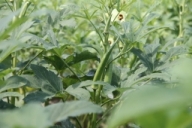
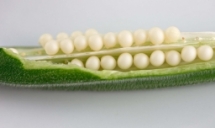
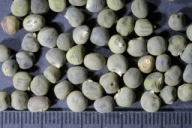

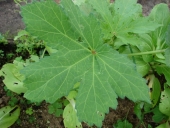
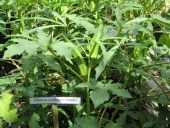

![Credit: © Kwan, The Plant Observatory Abelmoschus esculentus. [Lady's Finger, Okra] flower](images/Okra5128.jpg)
![Credit: © Kwan, The Plant Observatory Abelmoschus esculentus. [Lady's Finger, Okra] flower](images/Okra6128.jpg)
![Credit: © Kwan, The Plant Observatory Abelmoschus esculentus. [Lady's Finger, Okra] close- up](images/Okra8128.jpg)
